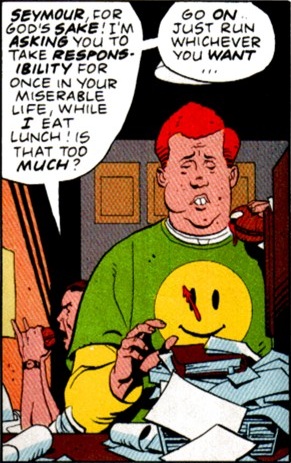So Status Quo has been accused of always playing the same three chords for long enough that they themselves can take the mickey out of it.Meanwhile, over in comics land, Tim O’Neil thought his dismissal of Doonesbury would not be controversial, because really, who still follows Doonesbury:
The best that can be said about Trudeau is that for a brief period of time he was an important cartoonist, and the worst that can be said is that he contributed materially to the development of his generation’s completely unironic self-fixation. Alex Doonesbury alludes to this fact in the 07/30 strip when she refers to the “aging hippie vibe” that permeates the proceedings. It should go without saying that the hippies are no longer “aging,” the hippies are officially “aged,” and the very idea that they get to officially “pass the torch” to succeeding generations is laughable. I would say that Doonesbury exists to cater to the self-regard of its audience, but I don’t really feel comfortable making any kind of pronouncements about the kind of people who follow the strip, if such people actually exist. The only people who pay attention to Doonesbury with any consistency are the newspaper editors who have to read it in order to make sure that this week’s sequence doesn’t offend the 70-year old Tea Partiers who comprise the main audience for all printed media these days.
Quite a lot of people, it turns out. (frex.) Now we could make this all about the difference between the critic and the audience and, depending on writer and their agenda, either scold the latter for their low taste or the former for their elitism and ivory tower eggheadism. But that would be dull. Let’s just take as our assumption that what a critic will look for, needs to look for in any work of art, will always be different from what the general audience will look for.
Certainly Tim wasn’t wrong about the deficiencies of Doonesbury as a comic. The art has never been anything but servicable and over the decades has had any trace of individuality leeched out of it. Storywise there hasn’t been much originality either, with plotting remaining the same mixture of (gentle) satire, soap opera and political commentary that Trudeau had down pat in the early seventies.
And yet…
Doonesbury‘s real qualities never lay with its art and in fact an argument could be made that better art, more personal art, would distract from those qualities. For Trudeau to get his messages through, the art must not be distracting, must be smooth and easily digestible. The same goes, to a lesser extent, for the storytelling.
Because what Doonesbury has done well over the decades is to stay relevant. Far from the baby boomer hippiefest Tim paints it as . it has constantly stayed angry. Only recently there was the abortion storyline, with several newspapers dropping these strips, while in the past decade he has of course spent a lot of time on Iraq, Afghanistan and the treatment of veterans of these wars.
These are not really comix virtues, so if you judge Doonesbury just on its comix merits, especially its art, you’ll miss why it is still such an important strip and why so many people, not just aging boomers are attached to it.

